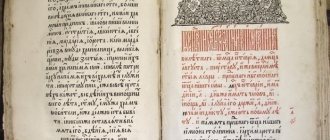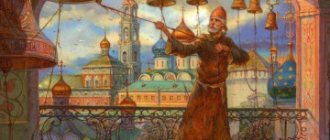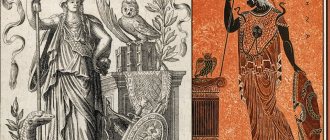Kamilavka
Kamilavka
(Greek Kαμιλαύκα, καμηλαύκιον, καλυμμαύχιον, καλιμαυι) - a headdress in the Orthodox Church of red, purple or black in the form of an expanding cylinder, is also a reward for priests [1].
Originally, it was a hat made of camel (Greek: κάμηλος) wool, which was worn in the Middle East for protection from the sun (hence the name).
Kamilavka was otherwise called skiadiy (from the Greek σκιά 'shadow') and was worn by the Byzantine emperor and his dignitaries. Soon becoming the headdress of clergy, the kamilavka acquired a characteristic shape (a cylinder without a brim, widened at the top). Since the 15th century, kamilavka (skiadion) began to be used not only by priests, but also by protodeacons. In addition, they began to make it from more expensive material. In the Greek Orthodox Church, the kamilavka is given to clergy at ordination and is an integral part of the priesthood.
In the Russian church, the kamilavka began to be used in the second half of the 17th century, replacing the skufia. This innovation caused protest from defenders of antiquity and was not popular among the Russian clergy. In 1798, the kamilavka was classified as one of the church awards [2] [3].
Currently, the black kamilavka is part of the liturgical vestment of the hierodeacon (and more recently also of the abbot); monks are supposed to wear a hood.
The kamilavka is worn both during and outside of worship. Representatives of the white clergy can only receive it as a reward. Such kamilavkas, unlike monastic ones, are usually purple (less often: any other color, but not black). According to the church charter, clergy during worship wear kamilavkas only at certain moments.
The Greek kamilavka differs from the Russian one in that it has small fields at the top of the cylinder; Russian kamilavka has no fields at all.
Symbolically, kamilavka means the crown of thorns of Jesus Christ and mortification of the flesh.
Among the Old Believers, “kamilavka” is a simple skufeika.
Source
[edit] See also
- Miter
- Skufja
| [+] Hats | |
| Clergy | Apostolnik • Biretta • Galero • Camauro • Kamilavka • Capello Romano • Klobuk • Doll • Miter • Papal tiara • Pileolus • Skufja |
| Military | Afghanka • Bergmütze • Beret • Peakless cap • Budenovka • Bustina • Grenadier • Glengarry • Headdress of an Indian warrior • Erichonka • Kartuz • Helmet • Adrian's helmet • Shako • Coif • Confederate • Kubanka • Mazepinka • Papakha • Pickelhelm • Cap • Field cap (field cap) • Titovka • Triglavka • Cap • Shaikacha • Paper cap • Iron cap • Helmet |
| Head decorations | Crown • Wreath • Veil • Diadem • Ical • Kika • Cockade • Kokoshnik • Crown • Liripip • Mask • Wig • Plume • Stefan • Papal Tiara • Hachimaki |
| Other | Armenian tiara • Akubra • Asian hat • Arakhchin • Arcele • Bandana • Bashlyk • Baseball cap • Balaclava • Balmoral • Bolivar • Bonet • Bryl • Eight-bladed • Gable (Tudor cap) • Double-cornered hat • Yarmulke • Kalfak • Kamala burek • Kamchat burek • Boater • Capa • Bonnet • Hood • Kattashi • Square academic cap • Kalagai • Cloche • Cowboy hat • Cap • Confederate hat • Coppola • Kerchief • Bowler • Keffiyeh • Frontal bandage • Litham • Mantilla • Namitka • Niqab • Non • Nightcap • Pacol • Panama • Burqa • Shawl • Mesh • Sombrero • Magpie • Three-cornered hat • Tem-o-shenter • Skullcap • Turban • Ubrus • Ushanka • Fez • Felt hat (fedora, trilby) • Phrygian cap • Hijab • Homburg • Top hat • Chador • Cap ( cap) • Montenegrin cap • Shaikacha • Shawl • Chaperon • Hat • Shapoklyak • Cap • Swimming cap • Foil cap • Hat • Sherlock Holmes hat • Pork pie hat • Shtreiml • Shute |
| see also | Gorlatnaya hat • Golden hat • Rabbit in a hat • Altabass hat • Kazan hat • Monomakh hat • Invisible hat |
| Clothes, shoes | |
And the story of the surplice
In ancient times, vestments similar to the surplice were known under such names as, for example, alba, tunic. All of them meant the usual lower clothing worn by men and women in ancient times. The surplice was used in all ancient churches. In ancient times, the surplice was made from flax and was white, as indicated by one of its names - alba (white). The surplice symbolizes the bright life of those dressed in it, personifies purity and innocence.
The rar is a long, wide ribbon made of the same material as the surplice. It is worn by the deacon on his left shoulder, above the surplice. The Orarion signifies the grace of God that the deacon received in the sacrament of the Priesthood.
Orarion (obsolete - orarium) is part of the liturgical vestment of a deacon and the liturgical vestment of a subdeacon. In Orthodoxy, the orarion is part of the liturgical vestments of protodeacons, as well as their corresponding members in the black clergy - hierodeacons and archdeacons. The orarion is made in the form of a long narrow ribbon made of brocade or other colored material. In Orthodoxy, the deacon wears an orarion over the surplice on the left shoulder, where it is fastened with a button loop, and its ends hang freely almost to the floor on the chest and back. The orarion can be of different colors, like other liturgical vestments. In Orthodoxy, the orarion is unofficially awarded to senior or experienced altar servers.
About the vestment in the orarion
During the process of ordination (ordination) to the subdeacon, the first vestment of the orarion occurs. After vesting the newly initiated in the surplice, other subdeacons bring the orarion to the bishop, who signs the orarion with the sign of the cross, after which the initiate kisses the orarion and the hand of the bishop, and the subdeacons gird the orarion in a cross shape around the orarion. During the ordination (ordination) of a subdeacon as a deacon, the orarion with which he was girded is removed from him, and the bishop places the orarion on his left shoulder, while saying: “Axios” (from the Greek - “Worthy”). In Orthodoxy, the deacon and subdeacon put on the orarion over the surplice only after a blessing received from the priest before the service. The blessing procedure includes making the sign of the cross three times and bowing to the cross of the Lord, after which the surplice and orarion are folded in a special way (at the same time, the deacon’s liturgical vestments also include armbands) and are presented to the priest with the words: “Bless, Vladyka, the surplice and orarion.” After receiving a blessing from the priest in the form of the sign of the cross, the deacon and subdeacon are vested.
D war orar
In Orthodoxy, after five years of service, a deacon receives his first award - the right to wear a double orarion. One of the two orarion is worn, as usual for a deacon, and the second orarion goes from the left shoulder, goes down to the right thigh, and is connected here at the ends. The liturgical vestment of the archdeacon and protodeacon is the protodeacon's orarion, which differs from the double orarion in that it has nine, and not seven, as on the simple and double orarion, crosses and the presence of the words “Holy, holy, holy,” as well as rich embroidery.
Armbands are narrow sleeves that are fastened with laces. The instructions remind the clergy that when they perform the sacraments or participate in the celebration of the sacraments of the faith of Christ, they do this not with their own strength, but with the power and grace of God. The guards also resemble the bonds (ropes) on the hands of the Savior during His suffering.
O blessing of the priesthood
The vestments of a priest consist of: a vestment, an epitrachelion, a belt, armbands and a phelonion (or chasuble).
Podryznik is a surplice in a slightly modified form. It differs from the surplice in that it is made of thin white material, and its sleeves are narrow with laces at the ends, with which they are tightened on the arms. The white color of the sacristan reminds the priest that he must always have a pure soul and lead an immaculate life. In addition, the cassock also resembles the tunic (underwear) in which our Lord Jesus Christ Himself walked on earth and in which He accomplished the work of our salvation.
E pitrahil is the same orarion, but only folded in half so that, bending around the neck, it descends from the front downwards with two ends, which for convenience are sewn or somehow connected to each other. The epitrachelion signifies the special, double grace compared to the deacon, given to the priest for performing the sacraments. Without an epitrachelion, a priest cannot perform a single service, just as a deacon cannot perform a single service without an orarion.
Links[ | ]
- Kamilavka - articles in BES and explanatory dictionaries by Dahl and Ozhegov
| Orthodox vestments (everyday and liturgical) | |||
| Stole Kamilavka Kaptyr Klobuk Cross with decorations Doll Mantle Miter Gaiter Pectoral cross Omophorion Orar Mace Panagia Paraman Polistavrion Podraznik Cassock Handguards Belt Cassock Sakkos Tablets Skufia Surplice Felon Rosary | |||
| Dictionaries and encyclopedias |
|
And the history of the stole
Epitrachelion (Greek - what is around the neck) is part of the liturgical vestment of an Orthodox priest and bishop. Starting from the 15th century, when ordaining a deacon to the priesthood, the bishop wrapped a deacon's orar around his neck in such a way that both ends evenly descended in front to the hem, and at the same time connected one to the other, creating an epitrachelion - an element of the vestments of Orthodox priests and bishops. Beginning around the 16th and 17th centuries, stoles, as an element of the vestments of an Orthodox priest, began to be made not from deacon’s oraria, but as a separate item of priestly vestment. Currently, the epitrachelion is made in the form of two separate strips of material, sewn to each other in separate places, into which conditional buttons are placed, since there are no loops. The epitrachelion is worn over the vestment (with full priestly vestments) or cassock (with small priestly vestments). The epitrachelion symbolizes the grace of the priesthood. Wearing the stole means that the priest does not lose the grace of the deaconate, but acquires double the grace of the deacon, giving him the right to be not only a minister, but also a performer of the sacraments. The bishop wears an epitrachelion as a sign of preserving the priestly graces. Without the epitrachelion, the priest and bishop cannot perform sacred rites. On each half of the stole there are three crosses - six in total. The crosses hung on the stoles symbolize the six sacraments of the church that a priest can perform. In the area of the priest’s neck, a seventh cross is hung on the stole, which indicates that the priest has accepted his ministry from the bishop and is subordinate to him, and that he bears the burden of serving Christ.
The belt is worn over the epitrachelion and cassette and signifies readiness to serve the Lord. The belt also signifies Divine power, which strengthens the clergy in carrying out their ministry. The belt also resembles the towel with which the Savior girded when washing the feet of His disciples at the Last Supper.
Armlets ( sleeves) are an element of the liturgical vestments of the Orthodox clergy. The straps are intended for tightening the sleeves of the vestment of priests (priests, archpriests) and bishops (bishops). The bridles are also part of the deacon's vestments. The handrails are made in the form of a wide strip of dense material with an image of a cross in the middle. The handrails cover the arms at the wrists and are tied with a cord on the inside of each arm. In this case, the image of the cross appears on the outside of the hands. The bonds represent the bonds by which Jesus Christ was bound. The Russian name for this element of vestment is “poruchi” which means that the priest entrusts (entrusts) himself to Christ during the service.
Other headdresses of the Russian Orthodox Church
Priests wear black hoods, i.e. starting with the hieromonk. The archbishop has a cross on his black hood, the metropolitan has a white hood with a cross.
And the bishop's miter differs from the usual one by the presence of a cross above the miter.
K ukol - Patriarchal headdress .
Notes[ | ]
- ↑ 12
Kamilavka // Explanatory dictionary of the living Great Russian language: in 4 volumes / author's compilation. V. I. Dal. — 2nd ed. - St. Petersburg. : Printing house of M. O. Wolf, 1880-1882. - Kamilavka // Small Encyclopedic Dictionary of Brockhaus and Efron: in 4 volumes - St. Petersburg, 1907-1909.
- ↑ 12
Kamilavka // Encyclopedic Dictionary of Brockhaus and Efron: in 86 volumes (82 volumes and 4 additional). - St. Petersburg, 1890-1907. - II. Hierarchical awards of the Russian Orthodox Church (inaccessible link).
- Christianity: Encyclopedic Dictionary: in 2 volumes / chapter. ed. S. S. Averintsev. - M.: Great Russian Encyclopedia, 1993. - T. 1: A - K.. - P. 672.
- Church Awards Archived February 3, 2009 on the Wayback Machine.
| Wiktionary has an entry for " Kamilavka " |
Additional Priesthood Robes
The cassock is the lower vestment of the Orthodox clergy - a long garment reaching to the toes with long narrow (unlike a cassock) sleeves. It is used not only during worship, but also outside it. During church services and at official receptions, the cassock must be black, but on vacation, at home, and during economic obediences, cassocks of any color are allowed.
Ryasa (from the Greek rason) - worn clothing, sackcloth) - the everyday outerwear of monastics and the priesthood, long to the toes, with a tightly buttoned collar, a robe with long wide sleeves, black .
The loose straight cut of the cassock and the predominantly black color symbolize inner peace, dispassion and detachment from worldly vanity.
Field uniform of a military chaplain
About Divine services and the symbolism of sacred clothing.
Literature[ | ]
- Subcap // Explanatory dictionary of the living Great Russian language: in 4 volumes / author's compilation. V. I. Dal. — 2nd ed. - St. Petersburg. : Printing house of M. O. Wolf, 1880-1882.
- Podkapok // Encyclopedic Dictionary of Brockhaus and Efron: in 86 volumes (82 volumes and 4 additional). - St. Petersburg, 1890-1907.
- Monastic robe // Encyclopedic Dictionary of Brockhaus and Efron: in 86 volumes (82 volumes and 4 additional). - St. Petersburg, 1890-1907.
- Monastic robe // New encyclopedic dictionary: In 48 volumes (29 volumes published). - St. Petersburg, Pg., 1911-1916.
- R. M. Kirsanova.
Kamilavka // Costume in Russian artistic culture of the 18th - first half of the 20th centuries: Experience of an encyclopedia / ed. T. G. Morozova, V. D. Sinyukova. - M.: Great Russian Encyclopedia, 1995. - P. 112-113. — 383 p.: ill. With. — 50,000 copies. — ISBN 5-85270-144-0.







